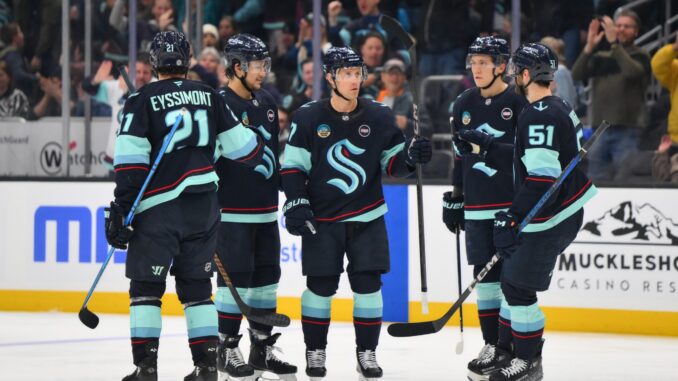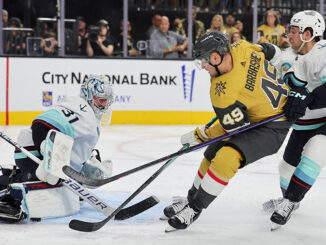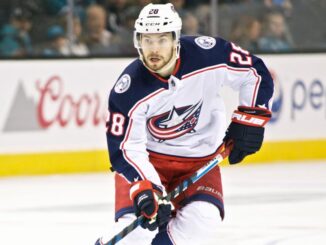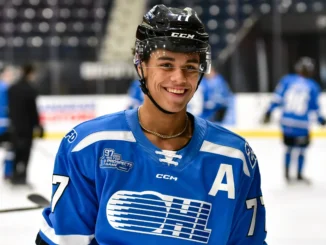
After losing to the Dallas Stars on Saturday night, the Seattle Kraken’s chase for the 2025 Playoffs is over. In combination with that loss, the St. Louis Blues put themselves out of reach with a win over the Colorado Avalanche. That result ensures that the Kraken will finish outside of the playoff picture for the second consecutive season, and third of four seasons overall since their inaugural campaign as an expansion team in 2021-22.
Missing the playoffs shouldn’t come as a surprise to anyone, given that the Kraken last sported a winning record on Dec. 12, after a win against the Boston Bruins put them at 15-14-2 for the season. The team has gone 16-23-4 in 43 games since then and currently has a worse points percentage (PTS%) this season (.459) than last (.494).
So, what’s gone wrong? As usual, the Kraken’s underwhelming efforts this season can’t be explained by any one reason, and a combination of factors has contributed to producing this result. Let’s dive into three of the main reasons for the Kraken failing to make the 2025 NHL Playoffs.
Goaltenders Struggled Behind a Weak Defense
The first reason for the Kraken’s poor season is actually two-fold. First, the team’s defensive structure is not great, which puts a great deal of pressure on its netminders.
According to Natural Stat Trick, the Kraken rank in the bottom 10 of the league by every meaningful defensive metric at five-on-five, including shots, chances, high-danger chances, and expected goals conceded per 60 minutes.
Those are poor numbers in isolation, but they are even worse when one considers that they fall well below the 50% mark in terms of on-ice share, meaning that they consistently cede territory to their opponents. It’s no surprise that their two main goaltenders—Joey Daccord and Philipp Grubauer—have struggled to perform consistently in that defensive environment.
Let’s start with Grubauer, who was sent down to the minors at the end of January and boasted a stat line of a 3.83 goals-against average (GAA) and an .866 save percentage (SV%) at the time. He then struggled in the minors (.893 SV% in seven games) but was called back up a month later after his brief exile.
The German goaltender ranks third-last in the league this season by goals saved above expected (GSAx), allowing nearly 14 more goals than expected given his workload. That has been a recurring trend since he joined the team ahead of its inaugural season, but the defensive structure, which has been above league-average the past three seasons, has done him no favors in 2024-25.
On the other hand, Daccord has been as advertised. The 28-year-old signed a five-year contract extension worth $5 million annually prior to the start of the season, with his new deal taking effect next season. He’s played in a career-high 51 games this season, and while his SV% (.908) has dipped since last season (.916), he owns an improved GSAx of plus-17.2.
As has been the case for several years, when Daccord sits this season, the team cannot overcome its leaky defensive structure. Finding Daccord a reliable backup should be one of the top priorities this offseason, even if it means buying Grubauer out of his expensive contract.
Significant Injuries to Key Players
It always feels like a slight crutch to blame injuries for a team underperforming, but the Kraken had to navigate the absences of star defenseman Vince Dunn and team captain Jordan Eberle this season.
Dunn suffered an early injury, limiting him to appearing in only 54 of the team’s 74 games this season. The team hasn’t been much better with him (23-26-5), but they could be hanging around the playoff race a little bit longer if he were fully healthy and allowed Ryker Evans to take on a more appropriate role.
Eberle has tallied 22 points in 34 games this season, a pace which would put him third in scoring if he were available all season. Few teams can successfully weather the absence of one of their more important forwards for over half of a season, and the Kraken’s lack of star talent made Eberle’s injury that much more consequential.
Kraken Special Teams Below Average
Although the majority of hockey games are played at five-on-five, the outcome of any given game hinges on the outcome of special teams play. A lethal power play can help overcome subpar play at even strength and give otherwise unspectacular teams an additional offensive boost. On the other hand, a porous penalty kill can make even the best goaltenders look average or worse, and allowing a poorly timed goal can be a massive momentum killer.
Neither of the Kraken’s special teams units have been very good this season on the surface and under the hood. The team ranks 23rd by power play efficiency (19.2%) and 22nd in penalty-kill success (76.5%), both of which sit in the bottom-third league-wide.
Low power play conversion can sometimes be blamed on unfortunate puck luck, but the Kraken didn’t create enough opportunities for that to be a legitimate excuse. The team generated very few shots (26th in the NHL), scoring chances (30th), and expected goals (31st) per-60-minutes with the man-advantage. The Kraken’s lack of potent offensive threats has been a longstanding issue for all of their four-year existence, and it’s yet to be meaningfully addressed and can be seen in the numbers.
Despite being below-average, the penalty kill could have looked even worse if it weren’t for the goaltending. The Kraken rank 31st in shots allowed, 30th in expected goals, and 30th in high-danger chances against per-60 minutes while shorthanded.
Those are not the results of well-constructed units, and should earn the backroom staff a rigorous post-season evaluation.
Kraken Must Look Forward for Rest of the 2024-25 Season
For all of the hand-wringing about the Kraken’s season, there is still hope on the horizon. Seattle has one of the more difficult remaining schedules in the NHL and could realistically fall as low as fourth-last in the league’s overall standings. This would lock in a top-six draft pick at minimum and give the organization’s already strong prospect pool a further boost.
General manager Ron Francis has also been on a mission to collect talented, but undervalued young players floundering in difficult situations (Eeli Tolvanen and Kappo Kakko, for example) and has gradually rebuilt the team’s foundation. While a handful of veterans remain on the roster, throwing the reins to the kids should be the move going forward, and the youth movement has already taken hold since the deadline.
The 2024-25 season has been a disappointing campaign overall, but 2025-26 and beyond promise to usher in the organization’s first golden era of competitiveness.
Data courtesy of Evolving Hockey, Natural Stat Trick and NHL.




